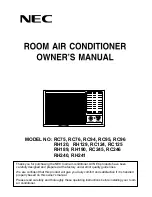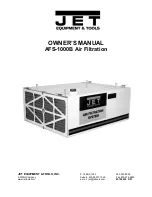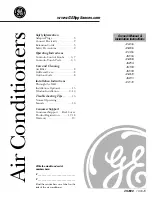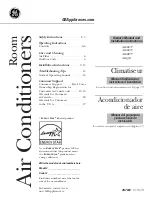
En-10
6. ELECTRICAL WIRING
WARNING
Electrical work must be performed in accordance with this Manual by a person certified
under the national or regional regulations. Be sure to use a dedicated circuit for the unit.
An insufficient power supply circuit or improperly performed electrical work can cause
serious accidents such as electric shock or fire.
Before starting work, check that power is not being supplied to the all units.
For wiring, use the prescribed type of cables, connect them securely, making sure that
there are no external forces of the cables applied to the terminal connections.
Improperly connected or secured cables can cause serious accidents such as overheat-
ing the terminals, electric shock, or fire.
Securely install the electrical box cover on the unit.
An improperly installed electrical box cover can cause serious accidents such as electric
shock or fire through exposure to dust or water.
Install sleeves into any holes made in the walls for wiring. Otherwise, a short circuit
could result.
Use the included connection cables and power cables or ones specified by the
manufacturer. Improper connections, insufficient insulation, or exceeding the allowable
current can cause electric shock or fire.
Do not modify the power cables, use extension cables, or use any branches in the wir-
ing. Improper connections, insufficient insulation, or exceeding the allowable current can
cause electric shock or fire.
Match the terminal block numbers and connection cable colors with those of the outdoor
unit (or RB unit). Erroneous wiring may cause burning of the electric parts.
Securely connect the connection cables to the terminal board. In addition, secure the
cables with wiring holders. Improper connections, either in the wiring or at the ends of
the wiring, can cause a malfunction, electric shock, or fire.
Always fasten the outside covering of the connection cable with the cable clamp. (If the
insulator is chafed, electric discharge may occur.)
We suggest installing GFEB breakers or follow local electrical code.
When installing this system, install using ground fault equipment breakers (GFEB) to
reduce the risk of leaking current which result in electric shock or potential fire.
Always connect the earth (ground) cable.
Improper earthing (grounding) work can cause electric shocks.
Install the remote controller cables so as not to be direct touched with your hand.
Perform wiring work in accordance with standards so that the air conditioner can be
operated safely and positively.
Connect the connection cable firmly to the terminal board. Imperfect installation may
cause a fire.
If the supply cable is damaged, it must be replaced by the manufacturer, its service
agent or similarly qualified persons in order to avoid a hazard.
CAUTION
Earth (Ground) the unit.
Do not connect the earth (ground) cable to a gas pipe, water pipe, lightning rod, or a
telephone earth (ground) cable.
Improper earthing (grounding) may cause electric shock.
Do not connect power supply cables to the transmission or remote controller terminals,
as this will damage the product.
Never bundle the power supply cable and transmission cable, remote controller cable
together.
Separate these cables by 2 in (50 mm) or more.
Bundling these cables together will cause miss operation or breakdown.
When handling PCB, static electricity charged in the body may cause malfunction of the
PCB. Follow the cautions below:
•
Establish an earth (ground) for the indoor and outdoor units and peripheral devices.
•
Cut power (breaker) off.
•
Touch metal part of the indoor unit for more than 10 seconds to discharge static elec-
tricity charged in the body.
•
Do not touch terminals of parts and patterns implemented on PCB.
6.1. Electrical requirement
•
Select the power cable type and size
in accordance with relevant local and
national regulations.
Voltage rating
208 / 230 V
Operating range
187 to 253 V
•
Specifications for local wiring power cord and branch wiring are in compliance with local
code.
•
Select the correct cable type and size according to the country or region’s regulations.
•
Max. wire length: Set a length so that the voltage drop is less than 2%. Increase the wire
diameter when the wire length is long.
Breaker should be installed at every refrigerant system. Do not use a breaker in a different
refrigerant system.
Refer to the table for the breaker specifications of each installation condition. Perform
the power crossover wiring within the range of the same refrigerant system. When the
crossover wiring is done, make a connection for indoor units to satisfy conditions A and B
below.
A. Current breaker requirements
Model
MCA
MAX. CKT. BKR
(Fuse capacity)
ARUL7TLAV2
0.71 A
15 A
ARUL9TLAV2
0.71 A
ARUL12TLAV2
0.71 A
ARUL14TLAV2
0.76 A
ARUL18TLAV2
0.76 A
MCA: Minimum Circuit Ampacity
MAX. CKT. BKR: Maximum Circuit
Breaker
When the power crossover wiring is
done, make it so that the total of the
MCA of the connected RB units and
indoor units does not exceed the 11 A.
For RB unit MCA, refer to the RB unit
installation manual.
If the capacity of connected RB units and indoor units exceeds the upper limit, either add
breakers or use a breaker with a greater capacity.
B. Ground Fault Equipment Breaker requirements
Breaker capac-
ity
Maximum connectable
“indoor units” or “indoor
units + RB units” (*1)
30 mA, 0.1 sec
or less
36 or less
100 mA, 0.1 sec
or less
37 to 121 (*2)
*1: Heat pump type: indoor units, Heat
recovery type: indoor units and RB
units.
*2: If the 100 mA capacity breaker is
not provided, split the quantity of
the indoor units into small groups
of 36 units or less and provide a
breaker with capacity of 30 mA for
each group.
6.1.1. Transmission and remote controller wiring specifications
Follow the specifications below for the transmission and remote controller cable.
Use
Cable size
(AWG)
Cable type
Remarks
Transmission
cable
22
LEVEL 4 (NEMA) non-polar 2 core,
twisted pair solid core diameter
0.026 in (0.65 mm)
LONWORKS®
compatible cable
Remote con-
troller cable
(2-wire type)
22 to 16
Sheathed PVC cable
Non polar 2 core,
twisted pair
18
Thermostat cable 2 core
Use sheathed non
twisted pair cable
6.2. Wiring method
Example
*2
*2
*2
Outdoor unit or RB unit *1
Breaker 1: Ground Fault Equipment
Breaker (GFEB)
Breaker 2: Maximum Circuit Breaker
(MAX. CKT. BKR)
Transmission
Transmission
Indoor unit
Remote controller
(Master)
Power supply
Indoor unit
Indoor unit
Power supply
Remote
control
Breaker 2
Breaker 2
Breaker 2
Breaker 1
Breaker 1
Breaker 1
Remote controller
(Slave)
Remote
controller
*1: When connecting to the Heat Recovery System, refer to the installation manual of the
RB unit.
*2: The 3-wire type remote controller is not used.
Indoor unit
Power supply
Pull box
Pull box
Breaker2
Breaker1
Power supply
Power supply
Power supply
: Disconnect switch
Indoor unit
Indoor unit
(Crossover wiring of power supply)
Disconnect switch shall be installed between indoor unit and pull box.
9374342556-02_IM.indb 10
27-Sep-19 10:30:08 AM




































